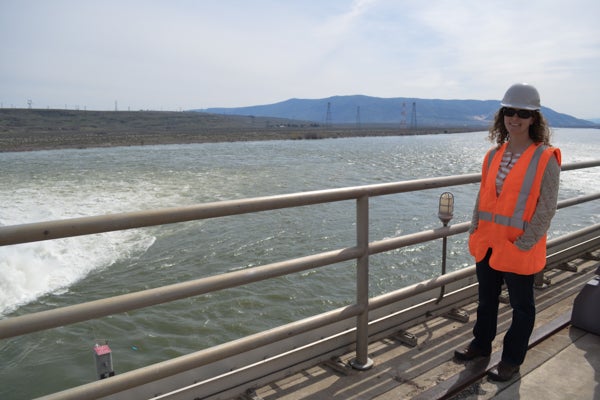This Washington state dam is trying to be fish-friendly
Listen 3:42
The Wanapum Dam on Washington State's Columbia River. (Eilís O'Neill/for WHYY)
The people at Wanapum Dam are trying to balance the interests of fish and clean power.
The Wanapum Dam is massive.
It’s a mile and a half across, spanning the width of the mighty, rushing Columbia River.
“It really looks like a concrete wall with transformers and electrical wires coming off of it. On the right bank, those are the spillways…those release water. And then the generation kind of powerhouse is sort of in the center of the river, and that’s what houses our ten turbines,” said Vanessa Seldal with Grant Public Utilities District.
The Wanapum is one of 11 dams on Washington State’s Columbia River, the largest river in the Pacific Northwest.
Those dams hold back the flow of the river, creating massive reservoirs. When the dams allow the water through, the falling water pushes giant turbines, which convert the mechanical energy of the water into the electrical energy that powers Washington’s cities and industries.
But there’s a catch.
“From the point of view of fish, there’s no upside to the dams,” said Thomas Quinn, a salmon scientist at the University of Washington.
That’s because in Washington dozens of dams are directly in the path of migratory salmon.
“We’ve certainly made matters more difficult for salmon in a number of ways,” Quinn said. “We’ve changed [the Columbia] from a rapidly flowing river to a series of large reservoirs with big artificial waterfalls – that is, the dams – in between them, and so the fish basically go through a lake and then a chute and then a lake and then a chute.”
Dams disrupt water flow and temperature. They slow the salmon’s journey through the river. And spinning through turbines can kill fish outright or disorient them, leaving them susceptible to predators.

Seldal’s tour of the Wanapum includes a climb up stairs to see one of the dam’s original turbines and 50 years of watermarks.
“It feels like we’re looking down kind of into this large tunnel,” Seldal said.
The dam has adjustable gates to let more or less water in depending on the energy generation need.
Everyone recognizes the importance of hydroelectric power, but many environmentalists and commercial and tribal fishermen want to remove older, less productive dams to give fish populations a chance to rebound.
But the Wanapum Dam, which generates enough electricity to power 400,000 homes, is not going away anytime soon. So the utility district is trying to balance the interests of fish and clean power.
The original dams on the Columbia River, built during the Great Depression, had no way for fish to get by — but, since then, “an awful lot of smart people have spent an awful lot of time using an awful lot of money to get this as good as they can,” Quinn said.
On the Wanapum Dam there’s a fish ladder: a kind of staircase for adult salmon to make their way up the river to spawn. In 2008, engineers added a fish slide, which pulls the water from the top of the reservoir and channels it into a 290-foot waterfall over the top of the dam.
It was specially made for juvenile fish that tend to stay near the water’s surface. The slide helps them pass the dam without going through the turbines.
The dam’s newer, more efficient turbines were also designed with salmon in mind. The turbines have fewer of what Vanessa Seldal calls “pinch and strike” points, so salmon are more likely to make it through alive.
“If [fish bypass structures] didn’t work, we wouldn’t have any salmon at all, so they work pretty well and have been improved markedly,” Quinn said.
“I guess you could say that the good news is salmon are still there…we still have salmon swimming up the Columbia River. You can go to the dams and watch them, and that in and of itself is a remarkable thing.”
WHYY is your source for fact-based, in-depth journalism and information. As a nonprofit organization, we rely on financial support from readers like you. Please give today.






